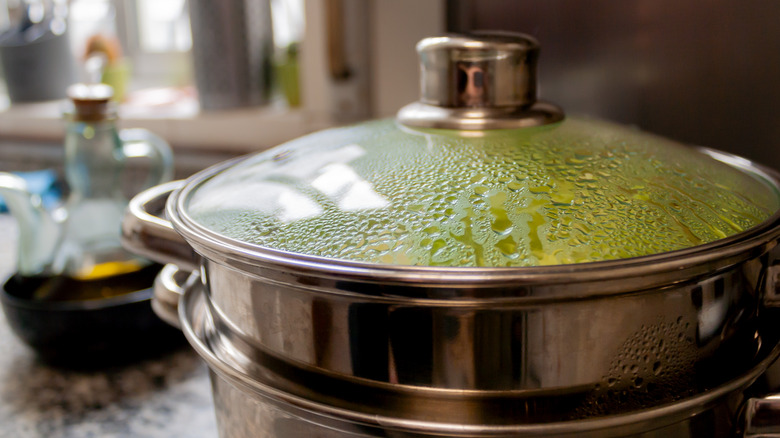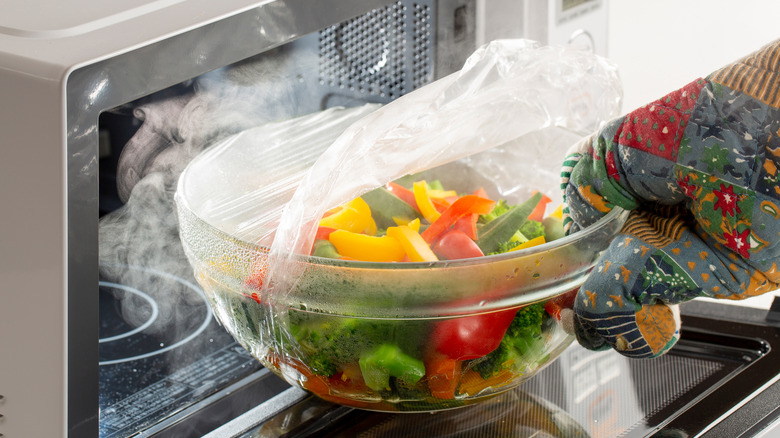Do You Need A Steamer Pot To Properly Steam Food?
It can be easy to fall into a rut whenever it comes to cooking. It is one of the few required daily activities for many of us — even those who don't want to. So, it is understandable for anyone to rely on the same kind of cooking day in and day out. Air fry this, slow cook that, put it in the oven at 350 degrees, and hope for the best. We all get stuck there, but one way to get out is to change things up with a new cooking method.
Steaming is one of the best cooking methods available, and it comes with tons of benefits. Roasting a chicken with lots of steam can help keep the meat from drying out, for example. Runner's World also says that steaming vegetables is good for keeping their, color, shape, and texture thanks to the gentle heat of steam. It also preserves more nutrition than other methods like boiling.
Grand Appliance adds that it's a good method for amateur cooks as well because it is more difficult to overcook foods with steam. Crave also notes that steaming can be a quick and easy way to prepare a meal. Just toss the food in the steamer, and let it cook. Plus, once you've mastered steaming you can use it in other ways, like steaming your french fries before baking them to achieve peak crispiness. Another benefit is that steaming doesn't require the specialized equipment that you might expect.
What is a steamer pot?
According to Cuisine At Home, the best way to steam food at home is to use a steamer pot. A steamer pot is a cooking item that consists of several pieces and is used specifically for steaming different foods. Typically a steamer pot has a large pot as the base, with one or more steamer inserts that rest on top of the base, and a lid. The Woks of Life adds that steamer baskets which are made from lighter materials than the metal for steamer pots are a similar option, though it's worth adding that you'll need a wok or other pan at the bottom to place the water in.
According to MasterClass, the way both of these devices works is that water is boiled in the bottom vessel, and the perforated steamer baskets or insert allow the steam to rise into these containers. It's all locked in then by the secured lids. This allows the foods to cook without ever coming into contact with the water or stove, and relies completely on steam power instead.
Whether you're steaming dumplings for big parties, or you steam food every day, these devices are highly effective tools to do so. However, if you're an average person who just wants to start cooking with steam sometimes though, you really don't need to buy specialized equipment like this.
Other ways to steam food
Per MasterClass, you can use any method to trap steam in a vessel with a raised cooking surface to steam food. Even with just a pot, a plate, and some aluminum foil, it's easy enough to steam ingredients without a steamer pot. Simply fill a large pot with water and bring it to a boil, then place equally sized aluminum foil balls throughout the water, and let a heat-resistant plate sit evenly on the foil without touching the water. Place the food on top of the plate, and cover it with a lid.
Jessica Gavin adds that a heatproof or metal colander can also get the trick done. Just boil water in a pot, place the colander containing the food on top, and seal it with a lid. Just make sure that you have a lid that will still fit over the colander, and trap the steam inside.
Meanwhile, Otao Kitchen says that you don't even need a pot to steam food, and it is as simple as reheating leftovers. Put your food in a microwave-safe dish, and sprinkle a few drops of water on top. Then, cover it with perforated plastic wrap and microwave it for a few minutes. That small amount of water will steam the food perfectly, and the microwave acts as a secondary steam trap as well.
There might be some cooking methods that require specialized equipment out there, but steaming definitely isn't one of them.


